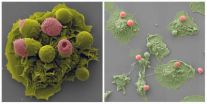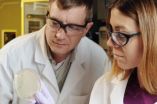(Press-News.org) Munich, Germany: Sleeping on animal fur in the first three months of life might reduce the risk of asthma in later childhood a new study has found.
The new research, presented at the European Respiratory Society (ERS) International Congress in Munich today (8 September 2014), suggests that exposure to the microbial environment in animal skin and fur could have a protective effect against asthma and allergies.
Previous studies have suggested that exposure to a wider range of environments fromyoung age could be protective against asthma and allergies. These findings have not been confirmed conclusively in urban settings. In this new study, researchers investigated children from a city environment who had been exposed to animal skin by sleeping on the material shortly after birth.
Data from a German birth cohort called Lisaplus were used. The cohort included over 3,000 healthy newborns who were mainly recruited in 1998.
The researchers collected information on exposure to animal skin during the first three months of life, along with information on the health of children until the age of 10 years. Information on 2,441 children was used in the study, with 55% of those included sleeping on animal skin in the first three months of life.
The results showed that sleeping on animal skin was associated with a reduced risk of a number of factors connected to asthma. The chance of having asthma at the age of 6 years was 79% lower in children who had slept on animal skin after birth compared with those who were not exposed to animal skin. The risk decreased to 41% by the age of 10.
Dr Christina Tischer, from the Helmholtz Zentrum München Research Centre, said: "Previous studies have suggested that microbes found in rural settings can protect from asthma. An animal skin might also be a reservoir for various kinds of microbes, following similar mechanisms as has been observed in rural environments. Our findings have confirmed that it is crucial to study further the actual microbial environment within the animal fur to confirm these associations."
INFORMATION: END
Sleeping on animal fur in infancy found to reduce risk of asthma
2014-09-08
ELSE PRESS RELEASES FROM THIS DATE:
The Lancet HIV: High rates of recreational drug use among HIV-positive gay and bisexual men in the UK strongly linked with condomless sex
2014-09-08
New research published in The Lancet HIV shows that polydrug use is common among HIV-positive men who have sex with men (MSM) [1] and is strongly linked to sex without a condom (condomless sex).
This is the largest questionnaire study of people living with HIV in the UK, accounting for about 5% of all HIV-diagnosed MSM in the UK. The findings show that half of MSM surveyed had used recreational drugs at least once in the previous 3 months [2]. About half of those who used drugs took three or more different types of drugs, while roughly a fifth said they had used five ...
The Lancet Respiratory Medicine: Benralizumab for chronic obstructive pulmonary disease and sputum eosinophilia
2014-09-08
Chronic obstructive pulmonary disease (COPD) is associated with eosinophilic airway inflammation in 10–20% of patients. Benralizumab, a monoclonal antibody, has been shown to decrease the number of blood and sputum eosinophils. In this trial of 101 patients with COPD whether benralizumab reduces the number of acute exacerbations was investigated. Benralizumab was found to be no more effective at preventing acute COPD exacerbations than placebo overall. However, the authors conclude that subgroup analyses suggest more research into the use of benralizumab in patients with ...
Dynamic duo takes out the cellular trash
2014-09-07
LA JOLLA—In most of the tissues of the body, specialized immune cells are entrusted with the task of engulfing the billions of dead cells that are generated every day. When these garbage disposals don't do their job, dead cells and their waste products rapidly pile up, destroying healthy tissue and leading to autoimmune diseases such as lupus and rheumatoid arthritis.
Now, Salk scientists have discovered how two critical receptors on these garbage-eating cells identify and engulf dead cells in very different environments, as detailed today in Nature Immunology.
"To ...
Platelet-like particles augment natural blood clotting for treating trauma
2014-09-07
A new class of synthetic platelet-like particles could augment natural blood clotting for the emergency treatment of traumatic injuries – and potentially offer doctors a new option for curbing surgical bleeding and addressing certain blood clotting disorders without the need for transfusions of natural platelets.
The clotting particles, which are based on soft and deformable hydrogel materials, are triggered by the same factor that initiates the body's own clotting processes. Testing done in animal models and in a simulated circulatory system suggest that the particles ...
Why age reduces our stem cells' ability to repair muscle
2014-09-07
Ottawa, Canada (September 7, 2014) — As we age, stem cells throughout our bodies gradually lose their capacity to repair damage, even from normal wear and tear. Researchers from the Ottawa Hospital Research Institute and University of Ottawa have discovered the reason why this decline occurs in our skeletal muscle. Their findings were published online today in the influential journal Nature Medicine.
A team led by Dr. Michael Rudnicki, senior scientist at the Ottawa Hospital Research Institute and professor of medicine at the University of Ottawa, found that as muscle ...
Rethinking the basic science of graphene synthesis
2014-09-07
A new route to making graphene has been discovered that could make the 21st century's wonder material easier to ramp up to industrial scale. Graphene -- a tightly bound single layer of carbon atoms with super strength and the ability to conduct heat and electricity better than any other known material -- has potential industrial uses that include flexible electronic displays, high-speed computing, stronger wind-turbine blades, and more-efficient solar cells, to name just a few under development.
In the decade since Nobel laureates Konstantin Novoselov and Andre Geim proved ...
Targeting the protein-making machinery to stop harmful bacteria
2014-09-07
One challenge in killing off harmful bacteria is that many of them develop a resistance to antibiotics. Researchers at the University of Rochester are targeting the formation of the protein-making machinery in those cells as a possible alternate way to stop the bacteria. And Professor of Biology Gloria Culver has, for the first time, isolated the middle-steps in the process that creates that machinery—called the ribosomes.
"No one had a clear understanding of what happened inside an intact bacterial cell," said Culver, "And without that understanding, it would not be ...
Continuing Bragg legacy of structure determination
2014-09-07
Over 100 years since the Nobel Prize-winning father and son team Sir William and Sir Lawrence Bragg pioneered the use of X-rays to determine crystal structure, University of Adelaide researchers have made significant new advances in the field.
Published in the journal Nature Chemistry today, Associate Professors Christian Doonan and Christopher Sumby and their team in the School of Chemistry and Physics, have developed a new material for examining structures using X-rays without first having to crystallise the substance.
"2014 is the International Year of Crystallography, ...
Ultraviolet light-induced mutation drives many skin cancers, Stanford researchers find
2014-09-07
A genetic mutation caused by ultraviolet light is likely the driving force behind millions of human skin cancers, according to researchers at the Stanford University School of Medicine.
The mutation occurs in a gene called KNSTRN, which is involved in helping cells divide their DNA equally during cell division.
Genes that cause cancer when mutated are known as oncogenes. Although KNSTRN hasn't been previously implicated as a cause of human cancers, the research suggests it may be one of the most commonly mutated oncogenes in the world.
"This previously unknown oncogene ...
Ultra-thin, high-speed detector captures unprecedented range of light waves
2014-09-07
New research at the University of Maryland could lead to a generation of light detectors that can see below the surface of bodies, walls, and other objects. Using the special properties of graphene, a two-dimensional form of carbon that is only one atom thick, a prototype detector is able to see an extraordinarily broad band of wavelengths. Included in this range is a band of light wavelengths that have exciting potential applications but are notoriously difficult to detect: terahertz waves, which are invisible to the human eye.
A research paper about the new detector ...



